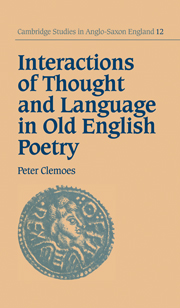Book contents
- Frontmatter
- Contents
- Illustrations
- Preface
- Abbreviations
- PART I The poetry of an aristocratic warrior society
- PART II The poetry of a universal religion
- 7 Vernacular poetic narrative in a Christian world
- 8 Poet, public petitioner and preacher
- 9 Symbolic language serving the company of Christ
- 10 Adaptation to a new material morality
- 11 From social hero to individual sub specie aeternitatis
- 12 Loyalty as a responsibility of the individual
- 13 This world as part of God's spiritual dominion
- Works cited
- Index I Quotations of two or more ‘lines’ of Old English poetry
- Index II A representative selection of the symbols and word pairs cited in discussion
- Index III General
9 - Symbolic language serving the company of Christ
Published online by Cambridge University Press: 18 December 2009
- Frontmatter
- Contents
- Illustrations
- Preface
- Abbreviations
- PART I The poetry of an aristocratic warrior society
- PART II The poetry of a universal religion
- 7 Vernacular poetic narrative in a Christian world
- 8 Poet, public petitioner and preacher
- 9 Symbolic language serving the company of Christ
- 10 Adaptation to a new material morality
- 11 From social hero to individual sub specie aeternitatis
- 12 Loyalty as a responsibility of the individual
- 13 This world as part of God's spiritual dominion
- Works cited
- Index I Quotations of two or more ‘lines’ of Old English poetry
- Index II A representative selection of the symbols and word pairs cited in discussion
- Index III General
Summary
Biblical ideas of society required relatively little adaptation from traditionally minded Anglo-Saxons, society for society. Especially they felt a natural affinity with the community which the Old Testament portrayed, living off their land, constantly protecting their patrimony by warfare, worshipping the one true God and obeying his anointed king. Converted Anglo-Saxons readily accepted Jewish society as an authentic model for their own. When consolidating a greater-than-West-Saxon authority in the late 880s and the 890s, King Alfred saw fit to preface his written body of vernacular laws with an introduction which set the code in a tradition stemming from Mosaic law, and, in a similar spirit, when supplying the brief argumenta for his vernacular prose translation of the first fifty psalms, he methodically related each psalm first of all to the historical David and then, by extension, to the user in the present.
Furthermore Jewish society sustained its traditions by means of a system of expression which was in itself congenial to Anglo-Saxons. The binary parallelism which was its primary form was like Old English apposition both in having been conventionalized in oral composition of poetry and in being based on meaning. Indeed, the direct bond between parallelism and sense was even more clearcut in the Hebraic variety of verse than in the Old English one.
- Type
- Chapter
- Information
- Interactions of Thought and Language in Old English Poetry , pp. 310 - 333Publisher: Cambridge University PressPrint publication year: 1995

